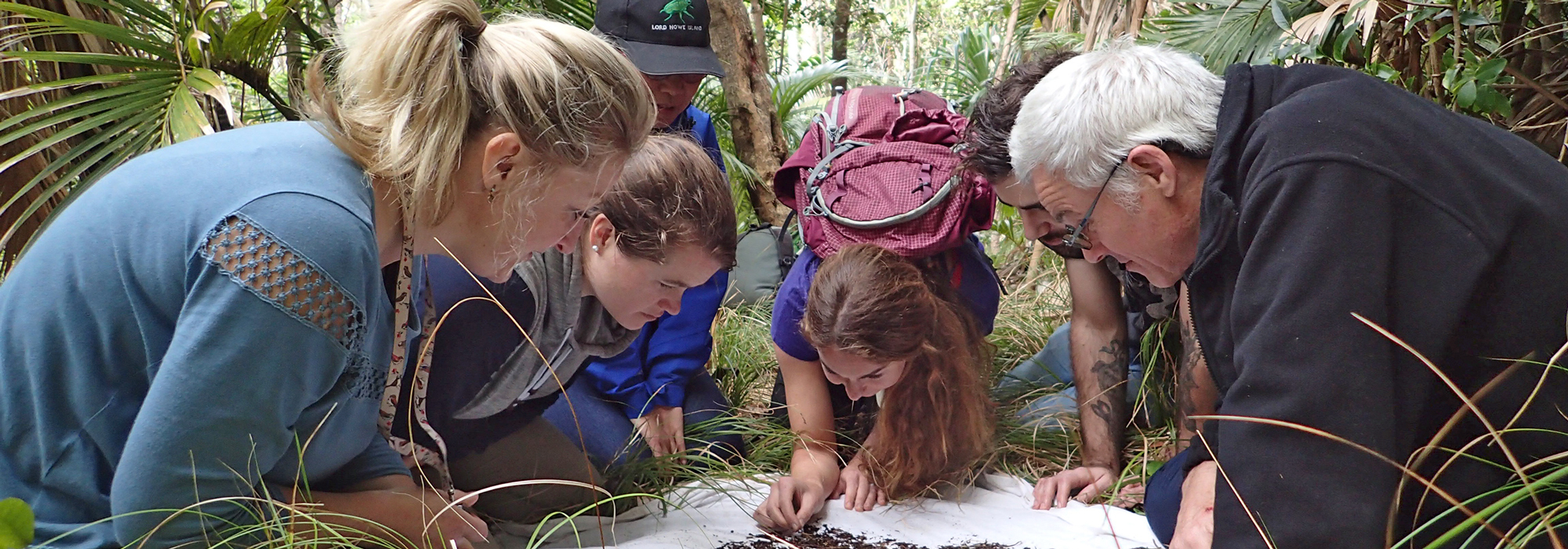
LEARN
HISTORY and CULTURE

Discovery
Discovery

Lord Howe Island was discovered on 17th February, 1788 by Lieutenant Henry Lidgbird Ball, commander of the armed tender of the First Fleet, HMS Supply. Lieutenant Ball was sailing from First Fleet headquarters in Sydney Cove to Norfolk Island where it was intended to found a second colony.
Ball did not land on Lord Howe Island until 13th March, 1788, on his return journey, when men from the Supply came ashore to explore the newly discovered island and claim it in the name of the Colony of New South Wales.
Many place names of the Island date to this very first visit. The Island was named after Lord Howe, who was the First Lord of the Admiralty at the time. Ball’s Pyramid and Mount Lidgbird were named after Lieutenant Henry Lidgbird Ball.
In that same year a number of other First Fleet ships visited the Island. Some of the sailors who came ashore made diary notes and even sketches of the Island and its birdlife.

Early Settlement
Early Settlement

From 1800 onward, Lord Howe Island became a well known stopover for whaling ships to obtain food and water.
This activity became so great that in 1833 three men came to live on the island to supply food to the ships crews. Messrs Ashdown, Bishop and Chapman, accompanied by their Maori wives and two Maori boys arrived from New Zealand on the barque Caroline. They settled at Hunter Bay, now known as Old Settlement, where they engaged in supplying ships with meat, fish and vegetables in exchange for other goods. They continued at Lord Howe until 1841 when Captain Owen Poole, retired naval officer, and Richard Dawson purchased their holdings for 350 pounds.
Later, in 1841, Poole took to the Island Messrs Wright, Hescott & McAuliffe and their wives. Thomas and Margaret Andrews arrived on the barque Rover’s Bride in 1842. All were employed to help carry on the industry commenced by Ashdown, Bishop and Chapman. In 1844 Dr John Foulis, who had bought a half of Poole’s share, arrived with his wife and daughter and four English emigrants.
In 1847, after they failed to obtain a lease of the Island from the NSW Government, the settlement on the Island was abandoned by Poole, Dawson and Foulis. Their employees were given the choice of returning to the mainland or continuing on the Island as independent settlers.
Thomas and Margaret Andrews eventually took over the Foulis home to the north of Windy Point (now Pinetrees Lodge). Their daughter Mary, born in 1846, later married Captain Thomas Gore Charles Nichols, master of a Tasmanian sailing vessel, and they had ten children, four boys and six girls. Descendants of Tom and Mary Nichols still live on the Island today.
In 1853, Nathan Chase Thompson, born in Massachusetts USA, a rigger on the whaling vessel Belle, arrived at the Island and settled. With him were two partners, George Campbell and Jack Brian, and two women and a girl from the Gilbert Islands (Kiribati). Thompson married one of the women, Boranga, and they had one child, who died in 1864 aged 11 years. Boranga died shortly after her son’s death, and Thompson later married Bogue who by then was 24 years of age. They had five children, two boys and three girls. Jack Brian left the Island in 1856 and Bogaroo the third Gilbert Island woman, died on the Island in 1880.
In 1879, Thomas Wilson was appointed the Island’s first school teacher and later he married his eldest pupil, Mary Thompson (daughter of Nathan and Bogue) and together they had six children, three boys and three girls. Needless to say there are very few families on the Island today who are not direct descendants or connected by marriage to the Thompson and Wilson unions, or the Andrews Nichols union.
During the first four decades of settlement, many others came to Lord Howe, with most staying for only a few years or less. Despite this turnover, by 1882 the Island had become a stable, multicultural community with its full share of romance, mystery and tragedy.
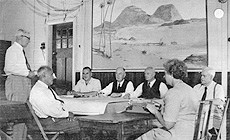
Administration
Administration

Lord Howe Island Government House, erected 1890.
Although control of Lord Howe Island was first vested in the British Crown, and later in the Parliament of New South Wales, the earliest settlers appear to have been too distant to warrant much attention from the authorities.
The first resident government official, Captain Armstrong, arrived in 1878 after the Island had been proclaimed a Forest Reserve. Captain Armstrong was a retired sailor of the Royal Navy, and held many posts including Forest Ranger, Resident Magistrate, Clerk of Petty Sessions, Postmaster and Registrar of Births, Deaths and Marriages.
Alas, Captain Armstrong also came into conflict with a section of the Island community. Local complaints were soon heard on the mainland, and in April 1882 the Hon J Bowie Wilson was sent to investigate the situation. He recommended that Armstrong be removed from the Island, though the Captain was subsequently vindicated by two Select Parliamentary Committees of Inquiry.
In the years following Armstrong’s departure, Island affairs were supervised by a series of visiting magistrates. These men usually visited the Island annually unless there was some particularly urgent matter that required their attention, in which case they came as required. Government House was built about 1890 as a residence for these visiting officials.
In 1912 a Board of Control was set up in Sydney to take control of the affairs of the Island. A three man local committee was established to advise the Board on all matters connected with the Island, and to carry out policy decisions arising from the Board’s deliberations.
This delicate balance between mainland and Island interests was maintained until August 1940, when the Board took the unprecedented step of appointing a Superintendent Mr Kennett the first resident administrative official since Captain Armstrong’s departure in 1882. Since 1940 a succession of administrators or managers have been appointed to the position.
Today the Lord Howe Island Board consists of four elected Islanders and three government appointees. A CEO on the island oversees Board policy and operations. The Board is responsible for all local government functions on the Island, including electricity generation, aerodrome operation, maintenance of public roads, buildings and tourist facilities, and supervision of the Island’s main industry - tourism. In 1982, with World Heritage Listing the responsibility for the environment became a major role of the Board. To carry out these functions, the Board employs a permanent staff of around 60 people.
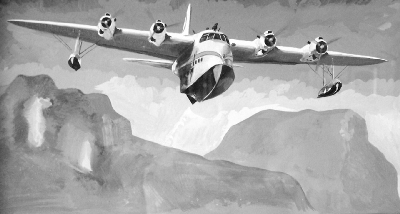
Flying Boats
Trans Oceanic Airways began the first commercial passenger service to Lord Howe Island in 1947.
Flying Boats

Francis Chichester landed on Lord Howe Island for fuel on his epic solo crossing of the Tasman Sea in 1931. Overnight a storm flipped his aircraft and he stayed on the island for nine weeks completely rebuilding the engine and wings of his aircraft Madam Elijah before continuing to Jervis Bay.
During World War II the RAAF flew Catalina flying boats to Lord Howe Island setting up and maintaining a meteorological station and radio base.
After the war various companies started flying boat services around Australia and the Pacific. Trans Oceanic Airways commenced the first commercial passenger service to Lord Howe Island in 1947, followed a few months later by QANTAS Airways. Catalina and Sandringham aircraft were used for this service. Ansett took over the service in the early 1950s.
Providing the last scheduled flying boat services in the world, the majestic Beachcomber, Islander and Pacific Chieftain, each able to carry 42 passengers, took off from Rose Bay in Sydney Harbour for the three hour journey to Lord Howe Island. There were up to six flights per week during the busy season. Flights were timed to arrive an hour before high tide to ensure take-off on the full tide. This often meant departing Rose Bay early in the morning, adding to the romance of the trip.
By 1974 the operation of flying boats had become uneconomic and so, after all efforts to retain them had failed, a 1,000 metre airstrip was constructed by Australian Army Engineers and land aircraft took over the air service to the Island.
The flying boat Beachcomber was taken to England in 1980 and takes pride of place in the Southampton Hall of Aviation where people can see the flying boat fitted in Ansett colours.

Shipping Days
Being a remote island 500 km from any other land, Lord Howe Island has a rich maritime heritage. During the early settlement the residents of Lord Howe Island relied upon passing ships to bring news of the outside world, supplies and passengers.
Shipping Days
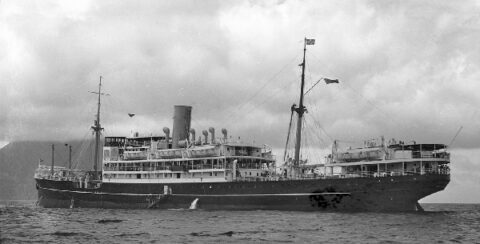
Being a remote island 500 km from any other land, Lord Howe Island has a rich maritime heritage. During the early days of settlement the residents of Lord Howe Island relied upon passing ships to bring news of the outside world, supplies and passengers.
The first regular trading vessel to the Island was the barque Rovers Bride , which commenced voyages in the 1840s. She was followed by a succession of similar small sailing vessels such as Sylph and Comet. In 1893 the Burns Philp company commenced a regular steamship service to the island. The SS Morinda, probably the best known of the Burns Philp ships to service the island, provided a passenger and freight service between 1932 and 1952.
After the Second World War these ships continued as a cargo service, but not as passenger service. These large vessels could not enter the lagoon, and unloading cargo took several days, every six weeks. In 1982 a smaller cargo boat started to come every two weeks with a cooler and freezer on board. The Island Trader (a ship operated by Birdon) now brings cargo from Port Macquaire each fortnight.
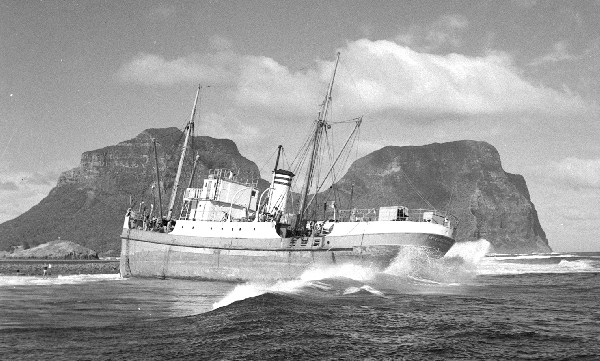
Shipwrecks
Shipwrecks

There are a number of ships that have come to grief around the Island.
In 1830, the whaling Brig George, 185 tons, hit a rock (now George’s rock) off the south east side of Mount Gower. The George was said to have been carrying a chest of gold coins, which the crew got ashore in the lifeboat, but this has never been found.
In 1837, the whaler Wolf struck a rock (now Wolf Rock) east of Mount Lidgbird.
In 1903 island trader SS Ovalau, 769 tons, with a load of copra caught fire off the Island and sank.
In 1907, the French naval vessel La Meurthe being towed from Sydney to New Caledonia broke a tow rope and ended up on the reef. The ship was burnt after copper fittings were removed.
In 1918, the trading ship SS Makambo hit a rock off Ned’s Beach and was run aground for repair. Many cases of fruit and tons of copra were thrown overboard. It was this event that brought rats to the island. Rats soon spread all across the Island wreaking havoc on birdlife and plantlife.
In 1954, the cargo boat Jacques del Mar ran onto the south side of North Passage. The ship was cut up and removed.
In 1963, the tuna boat Favourite dragged anchor at night and ended up on the north side of North Passage. The vessel was burnt to avoid planks washing into the lagoon and posing a hazard to the flying boats. Pieces of the metal structure washed into the lagoon and the engine is still visible on the reef.
More recently, in 2002 the British destroyer HMS Nottingham ran aground on Wolf Rock at night. After anchoring off Middle Beach for four weeks, repairs were sufficient to enable the ship to be towed to Newcastle. Eventually the destroyer was taken back to the UK for repair.
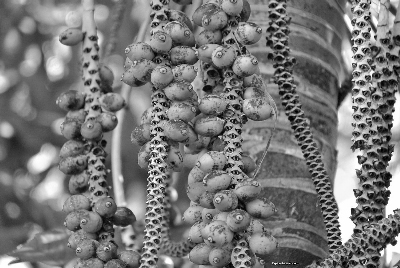
The Palm Industry
The Palm Industry

The lobby of the Savoy Hotel, London, 1904.
Lord Howe Island boasts four unique palm species, two of which prefer the moist humid conditions around the mountain summits, while the other two thrive along the lowlands, often in luxuriant, pure stands. One of these lowland palms, Howea forsteriana, has found extraordinary favour with nurserymen worldwide. Not only is it an attractive palm, but it survives indoors in the temperate climate of Europe better than other tropical palms.
Commencing around 1870, the Howea palm quickly became the doyen of indoor palms, gracing parlours, drawing rooms, ballrooms and hotel lobbies around the world. Nurserymen from Australia, America, England and various European countries eagerly sought its seed. They called it the Kentia Palm.
Two major significant developments in the palm seed industry were pioneered during the 1970s. The first of these was the export of live palms from the Island. Island resident, Alan Williams, was the first to germinate seed and export live seed sprouts to Belgium. Following his success, the LHI Board established its own nursery on the Island.
By 1981, palm seed exports had ceased entirely, and only live 20 cm high seedlings were being shipped from the Island. In 2016 the nursery was leased to private operators who grow palms for export, plus vegetables and native plants for use on the island. In 2021, a boutique brewery was established at the nursery to provide local beer for the island.

Tourism
Tourism

Prior to World War 1, ships operated by Burns Philp occasionally called at the Island to discharge cargo. Sometimes discharge of cargo was delayed because of adverse sea conditions and passengers came ashore to get respite from the motion of the sea. Often some passengers gladly accepted the hospitality of Islanders and enjoyed an overnight stay. By 1920 Burns Philip were quietly promoting the limited accommodation available in the homes of the Wilson family (Oceanview) and the Nichols family (The Pines, now Pinetrees).
By 1939 there were about 60 beds available for visitors. In addition to Oceanview and Pinetrees, the Dignam, Whiting and Austic families were catering for tourists. The income from tourism had reached a significant level.
The commencement of the flying boat service from Sydney in 1947 meant that access to Lord Howe was comparatively easy. Islanders responded to the increase in the number of visitors by improving and enlarging accommodation. More than 300 beds became available and at Christmas and other peak times the resident population was outnumbered by visitors.
The construction of the airstrip in 1974 resulted in the introduction of air services from Sydney, Brisbane and Port Macquarie. Today QantasLink service the Island with Dash 8 thirty-six seat aircraft. There is a variety of accommodation from self catering apartments, to guest house and luxury resort units. However most accommodation places are small, with just 20 to 40 beds.
In 1982 the Island Board limited the tourist beds to 400, and today visitors find a rare, quiet, uncrowded holiday destination to enjoy, explore and relax in. A range of quality tour services such as glass bottom boat, fishing, bird watching and guided walks are available. A network of walking tracks cover the island, for exploring on your own.
A number of small restaurants provide a high standard of food for visitors and locals.
In 2019, the island was listed by Lonely Planet as one of the top five destinations in the world to visit.
ENVIRONMENT

GEOLOGY
Lord Howe Island and Ball’s Pyramid are the last remnants of two volcanic seamounts that formed around 7 million years ago.
Geologists believe that there were two main volcanic episodes in the formation of Lord Howe Island.

CLIMATE
Lord Howe Island has a subtropical maritime climate. The seasons change gradually: winters are cool and wet with even rainfall; summers are warm and mild with fairly high but less regular falls of rain.

BIOGEOGRAPHY
One of the most intriguing processes in nature is the colonisation of Islands by plants and animals.
How do these tiny, remote specks in the ocean become populated by myriads of plants and animals?
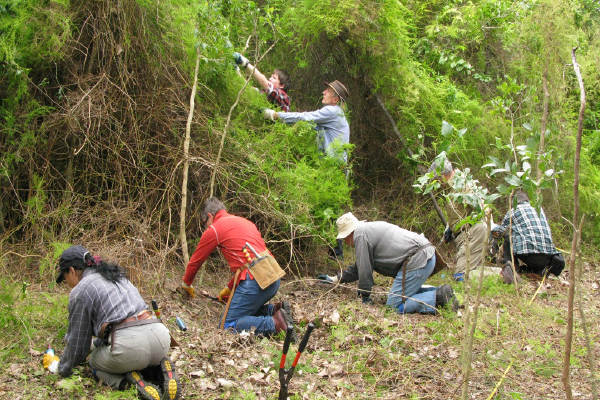
CONSERVATION
Lord Howe Island is a world leader in island conservation.
The NSW Government has recognised the unique flora and fauna of the island, from 1870 when the island was declared a Forest Reserve, culminating with World Heritage Listing in 1982.

BIODIVERSITY
The biodiversity on Lord Howe Island is extraordinary! On this tiny island there are 240 species of native vascular plants, over 100 moss species; over 200 different species of birds; around three to four thousand species of invertebrates; over 500 species of fish, more than 70 species of echinoderms; hundreds of species of molluscs… the list goes on and on.

SCIENTIFIC RESEARCH
Since the very early days of its settlement, Lord Howe Island has been the subject of extraordinary interest from the scientific community.
Today, the Museum regularly hosts national and international scientific programs, and is the venue for frequent symposia, and the base for many and varied research projects.
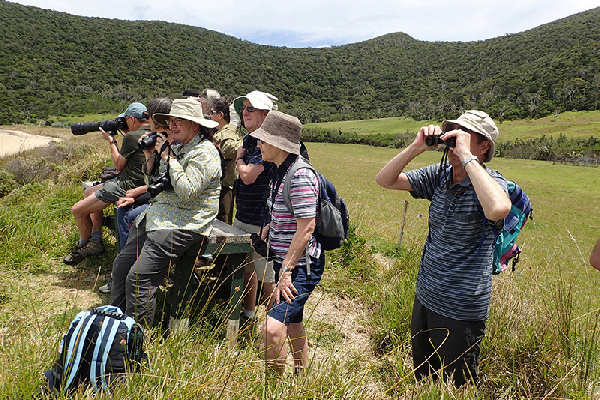
CITIZEN SCIENCE
The Lord Howe Island Museum has been holding Citizen Science programs since 2001, encompassing projects such as bird-watching, beach plastic monitoring, algae identification, seabird rescue, sea-slug photography and weed removal.

The Lord Howe white gallinule - now extinct
OTHER LEARNING RESOURCES

SCIENTIFIC PUBLICATIONS
The Museum holds an extensive collection of scientific journals with papers on various research topics related to the island. These include the flora, invertebrates, seabirds, landbirds, marine life, geology and conservation of the island, and of Middleton and Elizabeth Reefs.
More recent articles have been digitised as PDFs. Many older ones are original documents, which we plan to scan and add as searchable PDFs to the collection that will be available on computers at the museum.

MUSEUM NEWSLETTERS
The Lord Howe Island Museum newsletter is published monthly, and contains a wide variety of news, articles about the history of the island, and summaries of recent events of scientific and environmental interest.
Check out our latest newsletter.
Add your email to our mailing list:

CURATOR‘S BLOG
The Museum Curator, Ian Hutton regularly posts articles of interest in his blogs, both on this website and on his personal site:
Lord Howe Tours
Being a prolific photographer he also frequently posts images to Facebook:
Ian Hutton’s Facebook Page



